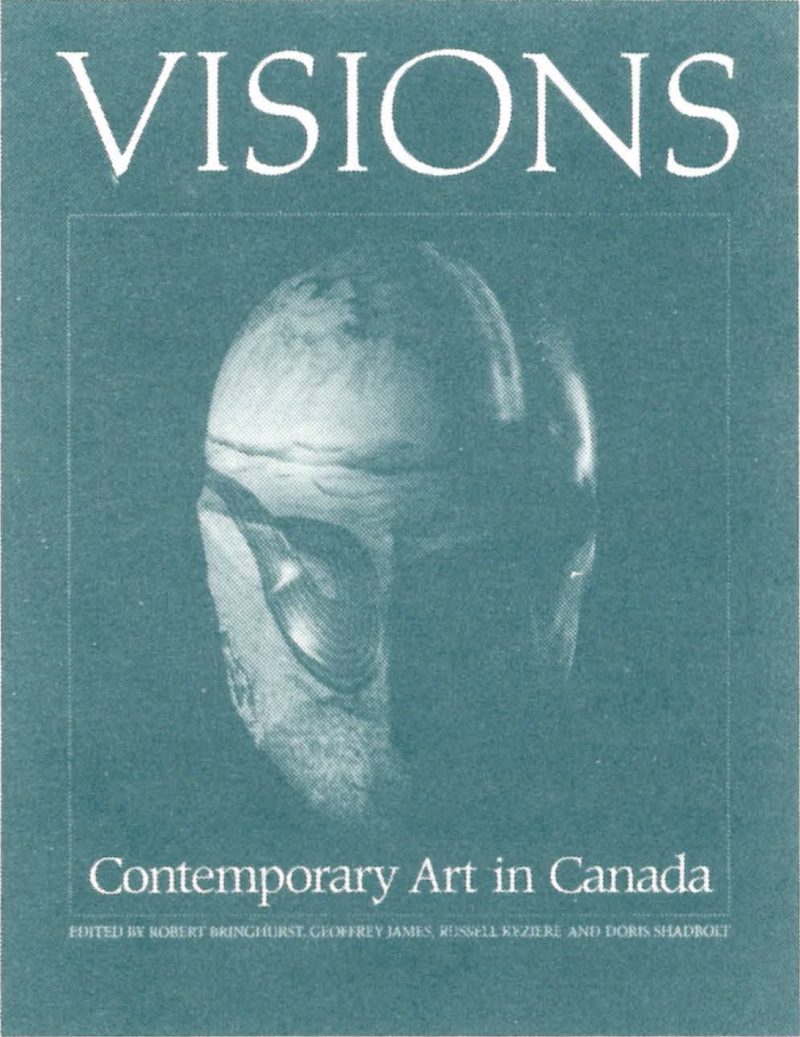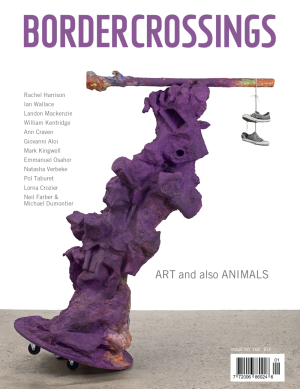“Visions: Contemporary Art in Canada” and “Contemporary Art”
Is it possible, given the size of Canada and the diversity of its regions, to provide a satisfactory survey of its art in one book? Two recent attempts suggest the answer is no.

Visions is an examination of Canadian art of the last forty years or so in the form of five essays by five different people. Here is a brief summary: Alvin Balkind kicks off with a sketch of the general development from the end of World War II to the present, by way of preparation for the more specialized discussions to follow. It used to be exciting and busy, he claims, with the real action in Montreal and Toronto, but we have hit the doldrums now. Terrence Heath follows with a thoughtful treatment of the importance of landscape and location in Canadian art. It has moved from what he calls Depiction (corresponding to Northrop Frye’s “Where is here?”) to Mediation (an attempt to answer the question “How is here?”). After Heath, Gary Michael Dault takes on abstract art, the dynamic of which, he claims, is derived mainly from two elements, the vertical and the horizontal (varied by the diagonal) which correspond, physically and emotionally, with basic human experience on a gravitational globe. However questionable his main thesis, his summing up of the work of Molinari, Town, and Otto Rogers is beautifully succinct. The next two essays, by Charlotte Townsend-Gault and John Bentley Mays are somewhat similar in their treatment of art as social protest. Townsend-Gault concludes that there is no great record in Canada of political awareness in art; rather there is now the dawning of a realization that it is impossible to remain neutral. Bentley Mays’ account of ‘alternative art’ forms is the liveliest essay in the book. Perhaps it is Mays’ evangelical fervour (despite the ironical pose that fools no one) that accounts for the spirit. It also apparently renders him unable to see that there is something faintly amusing in the spectacle of well-fed Canadian kids being given fat grants from the Canada Council to protest the inanities of Canadian middle-class life. Diana Nemiroff rounds off the collection by dealing with the emergence of conceptual art in Canada. She sees it as an attempt to dematerialize the traditional art object, then to turn attention from the object itself to the process of making it, and finally to examine the conventions of image-making and to use those conventions against themselves. This is a thoughtful essay, and I suspect that for many people it will make sense for the first time of many of the well-known but mysterious doings of conceptual artists, most of whom are masters of verbal obscurity when it comes to commenting on their own work.
Contemporary Canadian Art by David Burnett and Marilyn Schiff covers exactly the same period as Visions, but takes a somewhat different organizational approach to the task of covering the entire range of artistic activity (excluding native art) across Canada. About half the book is concerned with painting and is organized on regional principles; the other half is an untidy conglomeration of surveys of genres: Sculpture in the Sixties, Representational Painting, Alternative Modes, Recent Sculpture, Recent Painting.
Both books are certainly worth buying. Visions, for one thing, is sumptuously produced and the dozens of colour reproductions are of splendid quality. (The book is intended to parallel the TV series originating in Ontario, and has been subsidized by CPR). The essays are concerned to describe rather than to interpret, yet there is some commentary, so that they manage to be both informative and stimulating. The newcomer to Canadian art will be able to learn something about the developments of the last forty years, and the seasoned viewer will certainly find something to argue about. Contemporary Canadian Art, too, is a useful book. The authors, at least when writing about the east, have a gift for selecting the right detail from all the historical data, to weave a tight, convincing account that makes many things about the contemporary situation suddenly clear. They also pack in hundreds of names with hundreds of illustrations, which will make it useful as a first reference source—and the selected bibliography can then lead the reader to other, more specialized resources.
Even so, there is something unsatisfying about the whole process represented by these books, and it must have something to do with Canada’s territorial vastness. Both books suffer from a severe case of disjunctivitis. In Visions, the problem is aggravated by its structure as five separate essays (overseen, by the way, by no fewer than four editors—what on earth did they all find to do?). So the reader is taken on five separate roller-coaster rides. Each contributor gets on the car (usually) at Toronto, makes a longish stop at Montreal, dashes off on a sidetrip to Nova Scotia before a breathtaking surge across the prairies, ending with a swoop through the waterdip of Vancouver. After about the third such ride, the reader begins to feel a little dizzy. And also a little dissatisfied. Obviously Montreal and Toronto must figure prominently in any national account of Canadian art, but there is something about the repetition of the emphasis in Visions that begins to jar. Surely there must have been more to artistic activity in what Torontonians call ‘the regions’ than the book suggests. Winnipeg, with one or two exceptions, is strangely absent from the book. Alvin Balkind seems nervously aware of this fact: “As we move far west to Vancouver,” he says at one point, “stepping gingerly aside to avoid Winnipeg…” No explanation is offered for this omission, although the dustcover does illustrate a mask by Don Proch as if to try to make amends.
Contemporary Canadian Art reveals the same sense of imbalance, only more severely. In the section covering painting, for instance, the authors spend ninety pages on Montreal and Toronto (including a Toronto/London section), and a paltry twenty-eight pages on the rest of the country—the Maritimes, the Prairies, the West Coast. No wonder that here again Winnipeg is virtually ignored. The fact that artists from these regions do appear in the five sections covering the different genres cannot repair the sense of imbalance created by the first half of the book on painting. An illuminating passage occurs in the tiny section on the Maritimes. The authors have been discussing the work of Miller Brittain, and they conclude their comments by saying: “The issue is not whether Brittain was a great artist, nor whether major art can exist outside the major centres; the issue is that he was an artist, a witness and a voice in a generally hostile environment towards which he made no compromises.” Although it is true that Brittain was something of a special case, and although it is true that in other sections, notably that dealing with Emma Lake, the authors make an honest attempt to be comprehensive, these patronising remarks about Brittain nevertheless suggest a prejudice that may operate throughout the book. The prejudice can be summed up in this way: if something happens in Toronto it is important, if it happens in ‘the regions’ it is commendable. The questions that the authors casually brush aside in their statement about Brittain are precisely the questions that need to be addressed: is a particular regional artist good, and can major art exist outside of the major centres? (they are the same question). One gathers that the answer of the authors, at least to the second question, is probably no, which would account for the fact that a relatively lightweight artist like Jack Bush receives major attention, while a better artist, like Otto Rogers, receives only twenty-four lines.
Such imbalances are inevitable when an eastern-based writer sets out to survey the art of the whole country; a western-based critic would no doubt commit the same sin. Naturally one knows more about one’s own place and is disposed to think it is more important. The fault is not in the critic, but in the impossibility of the task. Perhaps the best way to approach these two books is to regard them merely as introductions to the specialized studies that must ensue. Only when we have a dozen or so books covering the various areas they touch on will we have enough information to derive a properly balanced view of art in this country. ♦
Peter Millard, who lives in Saskatoon, is a contributing editor to Arts Manitoba.

